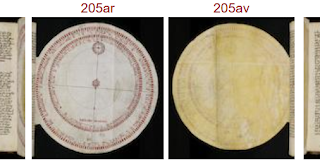But Aristotle had a different explanation, which he employed to argue that the Earth was the centre of the universe, and this was believed in the Middle Ages. It figures in a curious scientific manuscript just digitized at the Vatican and uploaded to the Bibliotheca Palatina website.
Here I will let John E Murdoch take over the story. He says the figure:
... pictures an argument that is found in both geometrical and natural philosophical works in the Middle Ages. It is alluded to, for example, in Roger Bacon in the thirteenth century, in Thomas Bradwardine and Nicole Oresme in the fourteenth, and in the margins of various medieval manuscripts of Euclid's Elements, as well as in the present fourteenth-century codex of a geometrical work ascribed to one Gordanus (not to be identified with Jordanus de Nemore). The argument relates to the meniscus of water or any other liquid contained in a vessel (since any point on such a surface is equally distant from the center of the universe). But this means that the closer the vessel is to this center, the more liquid it can contain when "full." This is so because the circular arc determining the surface of the liquid is "more curved" when the vessel is closer to the center of the universe, that is, the meniscus then “bulges" higher over the rim of the vessel. Indeed, it was even maintained that if such a vessel were absolutely full of liquid, moving the vessel further from the center of the universe would cause some of the liquid to overflow, since the surface of the liquid would become less curved.
The passage is at folio 114v of Pal.lat. 1389, one 24 fascinating scientific manuscripts uploaded in the past week:
- Pal. lat. 1369 Richardus ; Johannes ; Battānī, Muḥammad Ibn-Ǧābir /al-; Abū-Maʿšar Ǧaʿfar Ibn-Muḥammad; Messahalla; Iafar; Ptolemaeus, Claudius; Hali Imrani; u.a.: Astronomisch-astrologische Sammelhandschrift (Süddeutschland, Mitte 15. Jh.)
- Pal. lat. 1372 Alkabitius; Zael; Abū-Maʿšar Ǧaʿfar Ibn-Muḥammad; Messahalla: Astrologische Sammelhandschrift (Italien (?), 14. und 15. Jh.)
- Pal. lat. 1373 Messahalla; Prosdocimus ; Johannes Dank; Johannes de Lineriis; Prophatius Judaeus; Alfonso : Astronomisch-astrologische Sammelhandschrift (Südwestdeutschland, 1. Viertel 15. Jh.)
- Pal. lat. 1375 Johannes ; Johannes de Lineriis; Peuerbach, Georg /von; Johannes Regiomontanus; Philo ; Hermes: Astronomische Sammelhandschrift (Krakau, Ende 15. Jh.)
- Pal. lat. 1376 Johannes de Lineriis; Johannes Schindel; Thebit ben Chorat; Johannes Dank de Saxonia; Johannes ; Farġānī, Aḥmad Ibn-Muḥammad /al-; Alkabitius; Messahalla; Prophatius Judaeus: Astronomisch-mathematische Sammelhandschrift (Regensburg, St. Emmeran, 1447-1458)
- Pal. lat. 1379 Guilelmus de Velde: Empyreale minus (Südwestdeutschland, 1498)
- Pal. lat. 1380 Sammelhandschrift zum Quadrivium (Bologna und Paris, 1350--1366)
- Pal. lat. 1382 Alkabitius; Abulcasis; Albertus Magnus; Trotula; Thomas Cantimpratensis; Nicolaus de Polonia; Arnaldus de Villanova: Sammelband zur Astrologie und Medizin (Italien (I) , Südwestdeutschland (II) , Deutschland (III) , Italien (IV) , Deutschland (V), 13./14. Jh. (I) ; 14. Jh. (II) ; 1. Hälfte 14. Jh. (III) ; 13. Jh. (IV) ; um 1400 (V) ; 15. Jh. (1458) (VI) ; Ende 14. Jh. (VII))
- Pal. lat. 1383 Mathematisch-komputistische Sammelhandschrift (Heidelberg, Letztes Viertel 15. Jh.)
- Pal. lat. 1384 Johannes Regiomontanus; Johanens von Gmunden; Messahalla; Prosdocimo de Beldemandis; Gerardus Cremonensis (Sabionetta): Mathematisch-komputistischer Sammelband (Bayern (I) , Deutschland (II), um 1500 (I) ; 15. Jh. (II))
- Pal. lat. 1385 Alebertus de Brudzewo; Georg Peuerbach; Albubather: Astronomisch-astrologische Sammelhandschrift (Krakau, 1488)
- Pal. lat. 1386 Mischband: Handschrift und Drucke (Südwestdeutschland (Rottweil) (I) , Holland (Breda) (II), 1501 (I) ; um 1550 (II))
- Pal. lat. 1387 Prophatius Judaeus; Jacobus Bonet: Astronomische Sammelhandschrift (Norspanien, 1. Viertel 15. Jh.)
- Pal. lat. 1388 Andalò di Negro; Gerardus de Feltre; Albumasar; Alkindus; Ps.-Hippokrates: Astronomische Sammelhandschrift (Italien, 1478)
- Pal. lat. 1389 Mathematisch-astronomische Sammelhandschrift (Deutschland, 2. Hälfte 14. Jh.)
- Pal. lat. 1390 Messahalla; Ptolemaeus; Almansor astrologus; Ps.-Hermes; Thebit ben Corat; Johannes de Lineriis; Johannes Danck: Astronomisch-astrologische Sammelhandschrift (Frankfurt a.M., 1391-1436)
- Pal. lat. 1391 Johannes de Monteregio; Richardus de Wallingford; Marx Gyerhose; Johannes Virdung: Mathematisch-astronomische Sammelhandschrift (Heidelberg, um 1500)
- Pal. lat. 1392 Sammelband: Miszellaneen zu Astronomie, Astrologie, Mathematik, Medizin und Manik (Deutschland (I, III, V) , Frankreich (II) , Südwestdeutschland (IV), 15. Jh. (I, III, V) ; um 1300 (II) ; 16. Jh. (IV))
- Pal. lat. 1394 Sammelband (Noritalien (I) , Italien (II), 1. Hälfte 15. Jh. (I) ; 16. Jh. (II))
- Pal. lat. 1395 Commentum in Johannis de Sacrobosco tractatum de sphaera (16. Jh.)
- Pal. lat. 1396 Astrologisch-astronomische Miszellaneen (Heidelberg, um 1500)
- Pal. lat. 1399 Walter Lud; Johannes de Monteregio; Martin Waldseemüller; Alkindus: Mathematisch-astrologischer Sammelband (Süddeutschland, 1. Viertel 16. Jh.)
- Pal. lat. 1401 Beda; Thebit ben Corat; Albumasar; Hali Imrani; Roger Herfordensis; Ps.-Hippokrates; Messahalla; Alkindi; Ps.-Ptolemaeus: Zusammengesetzte Handschrift: astronomische und astrologische Texte (Schlesien (I) , Magdeburg (III), 1. Hälfte 15. Jh. (I) ; um 1200 (II) ; 14. Jh. (III))
- Pal. lat. 1402 Guido Bonatus: Liber astronomicus (Deutschland, Anfang 15. Jh.)
Murdoch, John E. Album of Science: Antiquity and the Middle Ages. New York: Scribner, 1984. Topic 254 (page 295).


















